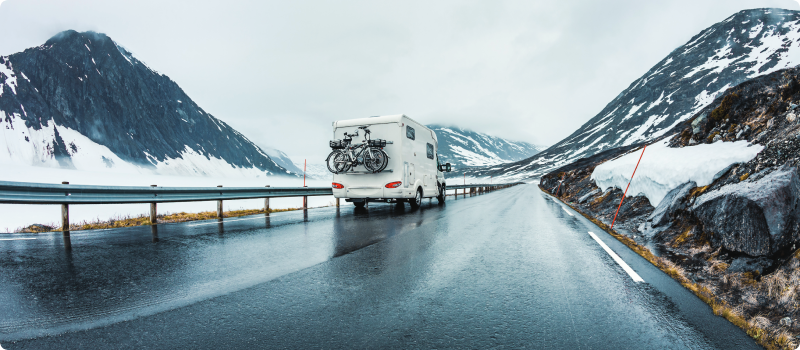As you wrap up your summer adventures, you’ll want to consider all that goes into winterizing your recreational vehicle. Winterizing your camper or RV not only saves it from damage — it makes it easier to get started next season! If you decide to do this work yourself, you’ll avoid paying an RV garage, and you’ll have a pretty good idea of what it takes to de-winterize your RV in the spring.
Whether you’ve got a big rig, trailer, fifth wheel or anywhere in between, take a look at these tips to get your ride ready for its winter hibernation.
What does it mean to winterize an RV?
Freezing temperatures can take their toll on more than just your rig’s water lines. Winterizing is primarily about keeping your water lines from freezing by flushing them and then adding antifreeze in certain places. As you’ll see, there’s really more to it than that.
Coverage That Travels with You
How much does it cost to winterize an RV?
It costs anywhere from $130 to $170 for a basic winterizing package at an RV dealer, depending on the size and class of your RV. But if you consider that you’ll probably be paying that same cost to de-winterize the RV in the spring, those costs can really add up over the years.
RV Winterization Tips
Some RVs are equipped with winterizing controls built in so take a look at your owner’s manual for details before you start. And before you get started get online or stop by your RV dealer to pick up the supplies for winter preparations:
- Nontoxic RV/marine antifreeze (propylene glycol) — around two to three gallons typically
- Tubing that connects to the black water holding tank and a cleaning wand
- A water pump converter kit or hosing that connects to the water pump inlet or an external hand pump
- A water heater bypass kit
- Hand tools to install and remove drain plugs
- Ant and roach traps
- Anti-rodent foam and peppermint granules
- A few cans of moisture absorbing dry-packs
How to Flush Your RV’s Plumbing System for Winter
If it’s recommended by your RV’s manufacturer, add RV antifreeze designed for RVs and campers. Follow these steps to get the water out of your RV:
- Remove any water line filters
- Drain and flush all freshwater tanks, systems and lines
- Drain, flush and clean the gray and black water holding tanks at an RV-approved dump station
- Turn off the water pump
- Drain the water heater tank by opening the pressure relief valve, but let the water cool down first
- Drain the fresh water and open all sink, shower and outside faucets to the on position
- Flush the toilet
- Open the hot and cold “low point” water drain lines by removing the plugs
- Turn on the water pump to assist draining water — turn it off right after draining to prevent damage

How to Fill Your RV’s Water Lines with Antifreeze
Most new RVs are now equipped with a hot water heater by-pass kit, which prevents the need to fill the tank with several wasted gallons of antifreeze. Don’t have one? Ask your RV dealer to install it. Here’s what you’ll need to do to get antifreeze into your water lines:
- Close all open faucets and water valves
- By-pass the water heater
- Install the water pump converter kit to get the antifreeze into the water system
- Turn on the water pump to circulate the antifreeze
- Working from the valve closest to the water pump, slowly open each valve until antifreeze begins to flow from it, then close it
- Replace the antifreeze container feeding the converter kit with a full one as necessary
- Repeat this for each valve working from closest to furthest from the water pump both inside and out
- Don’t forget washing machines and other appliances like ice makers
- Flush the toilet until antifreeze flows
- Pour a cup of antifreeze down each drain
- Pour the rest of your antifreeze into the freshwater tank
- Turn off your water heater’s heating element
- Verify all faucets are closed
Dealing with RV Pests Through the Winter
Don’t forget to protect your investment from insects, mice and critters. Bugs and rodents can find their way into your RV through small spaces leaving you with an expensive problem the following year. Here’s what you’ll need to do keep pests out of your RV:
- Remove all food from the RV
- Spray anti-rodent foam insulation into cracks and crevices — inside and out
- Place peppermint granules or packets across the RV interior and into areas where food and garbage was stored
- Place ant and roach traps around the RV

Winterizing Your RV’s Engine, Power Supply and Electrics
Here’s how to manage the motor, batteries and electrical systems before putting your RV away for the winter:
- Top off engine oil, brake, transmission, winter-ready windshield fluids as necessary
- Add fuel stabilizer and then fill the tank and run the engine for 5 minutes
- Top off the fluids in your batteries per manufacturer’s instructions
- Verify that all batteries are fully charged
- Disconnect and store batteries safely in a warm and dry location in freezing climates, or disconnect the batteries from their terminals – negative side first, for warmer climates
- Turn the RV’s main breaker to the off position
- Disconnect from shore power
- Remove all batteries from clocks, remotes, sensors, detectors
- Remove electronics, such as a TVs, tablets and laptops
- Follow manufacturer’s recommendations for on-board generator cold storage instructions
Steel Wool Can Help Keep Critters Out
Prepping Your RV’s Tires for Winter
Taking care of your RV tires during the winter months is just as important as attending to them out on the road. Follow your owner’s manual for off-season tire care. Here’s our advice on managing your tires:
- Park the RV on concrete if possible
- Set the parking brake
- Set wheel chocks
- Engage the leveling jacks (not stabilizing jacks) to prevent the tires from developing flat spots
- Use external jacks to lift the RV
- You can also just move the RV half a tire rotation two or three times over its winter break
- Lower the stabilizing jacks enough to keep the RV steady while you’re inside it, but it shouldn’t be taking on any load
- Spray the RV with UV protecting conditioner
- Cover the tires for the winter
Managing Propane Sources and Fittings
Propane can expand and contract when the temperature changes and that can lead to leaks and problems next year. Here are a few things to do to help keep your propane tanks working well:
- Refill all propane tanks
- In freezing climates, remove external propane tanks and safely store in a protected and warm place — but not in the RV
- Protect propane fittings with plastic bags and rubber bands
- Replace any hoses or fittings that are showing signs of cracking or wear
Take on Spring Cleaning Before Winterizing
Much like vacation homes, you should unplug, clean the refrigerator and leave the door open during storage to prevent mold and mildew. Remove any food items, toiletries and medicines. Spend a little time wiping down and cleaning up your RV before you put it to bed for the winter:
- Vacuum all floors and carpets
- Spray down and wipe all surfaces
- Remove all bedding, clothes and linens for laundering
- Place cans of dry-packs silica around the RV

Winterizing Your RV’s Exterior, Roof and Awning
Protecting your RV from harsh winter weather can add years to its life. These tips can help you keep your RV’s awning and everything else in great shape while it’s in storage:
- House your RV under a shelter
- Cover the RV with a breathable tarp
- Place a waterproof tarp on the surface where the RV will rest
- Extend the awning fully and wash it according the manufacturer’s directions, rolling it back up after it’s completely dry
- Apply a slip-on awning cover (rigid, if possible) to protect it from the elements
- Close every roof vent and plug other vents open to the air with steel wool or aluminum
- Apply silicon caulk to the exterior where small cracks have developed
- Cover the AC unit
- Clean the sewer hose and store it
It may seem like a lot to do but with a little work, you can add years of enjoyment to your RV or camper. And before you know it — it’ll be time for another season of adventures!
As you’re giving your RV some TLC this fall, remember to check in with your American Family Insurance agent and review your coverage options. With a well-crafted policy and a solid winterization strategy, your RV can be protected from the elements and the unexpected — taking you onto the open road well into the future.
This article is for informational purposes only and based on information that is widely available. We do not make any guarantees or promise any results based on this information.
Tools & Resources
NextScripts
JSS component is missing React implementation. See the developer console for more information.

